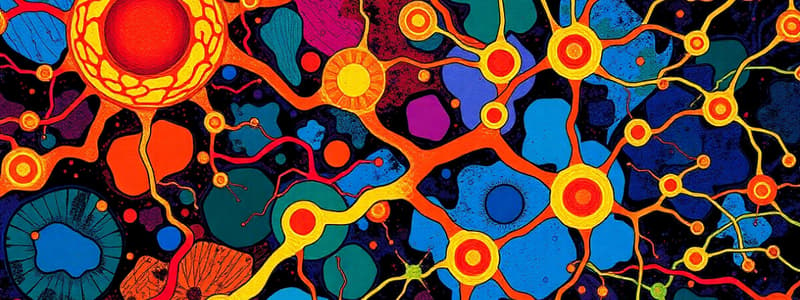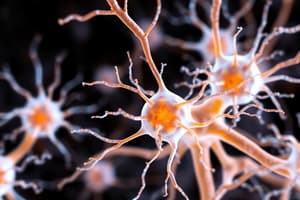Podcast
Questions and Answers
Which anatomical division of the nervous system includes the brain and spinal cord?
Which anatomical division of the nervous system includes the brain and spinal cord?
- Peripheral nervous system
- Somatic nervous system
- Autonomic nervous system
- Central nervous system (correct)
What primary function is associated with the occipital lobe of the cerebral cortex?
What primary function is associated with the occipital lobe of the cerebral cortex?
- Visual processing (correct)
- Sensory integration
- Language comprehension
- Motor control
In a neuron, what is the main function of the myelin sheath?
In a neuron, what is the main function of the myelin sheath?
- To increase the speed of electrical signal transmission along the axon (correct)
- To provide structural support to the cell body
- To synthesize neurotransmitters
- To transmit signals directly to the dendrites
Which glial cell type is responsible for forming the myelin sheath around axons in the peripheral nervous system?
Which glial cell type is responsible for forming the myelin sheath around axons in the peripheral nervous system?
What is the primary role of the somatic nervous system?
What is the primary role of the somatic nervous system?
What is the primary function of the dorsal root ganglion?
What is the primary function of the dorsal root ganglion?
Which event is most directly responsible for the repolarization phase of an action potential?
Which event is most directly responsible for the repolarization phase of an action potential?
Which neurotransmitter is primarily associated with the parasympathetic nervous system?
Which neurotransmitter is primarily associated with the parasympathetic nervous system?
What is the role of the longitudinal fissure in the brain?
What is the role of the longitudinal fissure in the brain?
Which of the following is a key function of the medulla oblongata?
Which of the following is a key function of the medulla oblongata?
Which structure in the spinal cord cross-section contains the cell bodies of motor neurons that innervate skeletal muscles?
Which structure in the spinal cord cross-section contains the cell bodies of motor neurons that innervate skeletal muscles?
What is the primary function of the autonomic nervous system (ANS)?
What is the primary function of the autonomic nervous system (ANS)?
Which of the following accurately describes the direction of impulse conduction in a neuron?
Which of the following accurately describes the direction of impulse conduction in a neuron?
In the context of sensory perception, what distinguishes general senses from special senses?
In the context of sensory perception, what distinguishes general senses from special senses?
Which of the following lists the meninges from outermost to innermost?
Which of the following lists the meninges from outermost to innermost?
What is the primary function of the prefrontal cortex, located in the frontal lobe?
What is the primary function of the prefrontal cortex, located in the frontal lobe?
Which division of the autonomic nervous system is responsible for the "fight or flight" response?
Which division of the autonomic nervous system is responsible for the "fight or flight" response?
How do graded potentials differ from action potentials?
How do graded potentials differ from action potentials?
Which plexus gives rise to the nerves that innervate the upper limb?
Which plexus gives rise to the nerves that innervate the upper limb?
What is the role of schwann cells in the peripheral nervous system?
What is the role of schwann cells in the peripheral nervous system?
Flashcards
What is the brainstem?
What is the brainstem?
Controls basic functions like breathing, heart rate; includes medulla oblongata, pons, midbrain.
What are the major functions of the nervous system?
What are the major functions of the nervous system?
Sensation, integration, and response.
What is resting membrane potential?
What is resting membrane potential?
A difference in electrical potential across the cell membrane when the cell is not active.
What is a dendrite?
What is a dendrite?
Signup and view all the flashcards
What is the axon?
What is the axon?
Signup and view all the flashcards
What is the myelin sheath?
What is the myelin sheath?
Signup and view all the flashcards
What are Nodes of Ranvier?
What are Nodes of Ranvier?
Signup and view all the flashcards
What are Schwann cells?
What are Schwann cells?
Signup and view all the flashcards
What are the regions of the spinal nerves?
What are the regions of the spinal nerves?
Signup and view all the flashcards
What is the cerebrum?
What is the cerebrum?
Signup and view all the flashcards
What are the meninges?
What are the meninges?
Signup and view all the flashcards
What is the somatic nervous system?
What is the somatic nervous system?
Signup and view all the flashcards
What are the major lobes of the cerebral cortex?
What are the major lobes of the cerebral cortex?
Signup and view all the flashcards
What are the divisions of the autonomic nervous system?
What are the divisions of the autonomic nervous system?
Signup and view all the flashcards
What is the function of the sympathetic nervous system?
What is the function of the sympathetic nervous system?
Signup and view all the flashcards
What is the function of the parasympathetic nervous system?
What is the function of the parasympathetic nervous system?
Signup and view all the flashcards
What are the pons?
What are the pons?
Signup and view all the flashcards
What is the thalamus?
What is the thalamus?
Signup and view all the flashcards
What is the cerebellum?
What is the cerebellum?
Signup and view all the flashcards
Study Notes
Chapter 12: Nervous System and Nervous Tissue
- The major anatomical divisions of the nervous system are the central nervous system (CNS), comprising the brain and spinal cord, and the peripheral nervous system (PNS), consisting of all nervous tissue outside the CNS.
- The functional divisions of the nervous system include the sensory (afferent) division, which transmits impulses from receptors to the CNS, and the motor (efferent) division, which transmits impulses from the CNS to effector organs (muscles and glands).
- Gray matter consists of neuron cell bodies, dendrites, and unmyelinated axons; functionally, it is involved in processing and integration of information.
- White matter consists of myelinated axons; it is primarily involved in transmitting nerve impulses over long distances.
- The parts of a multipolar neuron, in order of polarity, are the dendrites, cell body (soma), axon hillock, axon, and axon terminals.
- Types of glial cells in the CNS include astrocytes (support, regulate ions and neurotransmitters), oligodendrocytes (myelination), microglia (immune defense), and ependymal cells (line cavities, produce CSF).
- The main types of glial cells in the PNS include Schwann cells (myelination) and satellite cells (support and regulate neuron environment).
- The major functions of the nervous system encompass sensation (detecting internal and external stimuli), integration (processing and interpreting sensory input), and response (activating effectors to produce a reaction).
- The resting membrane potential is established by the distribution of ions (Na+, K+, Cl-) across the cell membrane, the selective permeability of the membrane to these ions, and the action of the Na+/K+ pump.
- During an action potential, the membrane undergoes depolarization (due to Na+ influx) and repolarization (due to K+ efflux).
- Graded potentials vary in magnitude and can be either depolarizing or hyperpolarizing, while action potentials are all-or-none events.
- Neurotransmitters can be categorized by chemical type (e.g., acetylcholine, amino acids, biogenic amines, neuropeptides) and by their effect (excitatory or inhibitory).
Chapter 13: Anatomy of the Nervous System
- The embryonic nervous system develops from the neural tube, which forms the CNS structures (brain and spinal cord).
- Major regions of the adult nervous system include the cerebrum, diencephalon (thalamus, hypothalamus, epithalamus), brainstem (midbrain, pons, medulla oblongata), cerebellum, and spinal cord.
- Regions of the cerebral cortex can be located based on anatomical landmarks such as the central sulcus (separates frontal and parietal lobes), lateral sulcus (separates temporal lobe), and longitudinal fissure (separates cerebral hemispheres).
- The spinal cord in cross-section has regions including the anterior (ventral) median fissure, posterior (dorsal) median sulcus, gray matter (anterior, posterior, and lateral horns), and white matter (anterior, posterior, and lateral columns).
- The cranial nerves, in order of anatomical location, are: olfactory (I), optic (II), oculomotor (III), trochlear (IV), trigeminal (V), abducens (VI), facial (VII), vestibulocochlear (VIII), glossopharyngeal (IX), vagus (X), accessory (XI), and hypoglossal (XII).
- Spinal nerves are listed by vertebral regions: cervical (C1-C8), thoracic (T1-T12), lumbar (L1-L5), sacral (S1-S5), and coccygeal (Co1).
- The cervical plexus supplies nerves to the neck, shoulder, and diaphragm.
- The brachial plexus supplies nerves to the upper limb.
- The lumbar plexus supplies nerves to the anterior and medial thigh.
- The sacral plexus supplies nerves to the posterior thigh, leg, and foot.
Chapter 14: The Somatic Nervous System
- The somatic nervous system comprises sensory receptors, sensory neurons, and motor neurons that control skeletal muscles.
- General senses include touch, temperature, pain, and pressure, distributed throughout the body.
- Special senses include vision, hearing, taste, and smell, located in specific organs.
- Regions of the central nervous system that contribute to somatic functions are the cerebral cortex (motor and sensory areas), basal ganglia (motor control), cerebellum (coordination), and spinal cord (reflexes).
- The stimulus-response motor pathway involves sensory receptors detecting a stimulus, sensory neurons transmitting information to the CNS, the CNS integrating the information, and motor neurons transmitting commands to skeletal muscles for a response.
Chapter 15: The Autonomic Nervous System
- The autonomic nervous system (ANS) components include visceral sensory neurons, integrating centers in the CNS, and autonomic motor neurons that innervate smooth muscle, cardiac muscle, and glands.
- The sympathetic division (fight or flight) has short preganglionic fibers and long postganglionic fibers, with ganglia located close to the spinal cord.
- The parasympathetic division (rest and digest) has long preganglionic fibers and short postganglionic fibers, with ganglia located near or within the effector organs.
- Visceral reflexes include a sensory receptor, afferent neuron, integrating center, efferent neurons (preganglionic and postganglionic), and an effector (smooth muscle, cardiac muscle, or gland).
- Target effector responses to autonomic input depend on the signaling molecule released; norepinephrine (sympathetic) can be excitatory or inhibitory via adrenergic receptors, while acetylcholine (parasympathetic) is typically excitatory via muscarinic receptors.
- The central nervous system coordinates and contributes to autonomic functions through the hypothalamus (major control center), brainstem (reflex centers), and cerebral cortex (emotional influences).
Studying That Suits You
Use AI to generate personalized quizzes and flashcards to suit your learning preferences.




